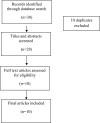Child and adolescent mental health problems in Nepal: a scoping review
- PMID: 31413728
- PMCID: PMC6689861
- DOI: 10.1186/s13033-019-0310-y
Child and adolescent mental health problems in Nepal: a scoping review
Abstract
Introduction: Globally, 10-20% of children and adolescents suffer from mental disorders, with half of all them starting by the age of 14 and three-quarters before the age of 25. In Nepal, 40% of the population is younger than 18 years of age, and as such there is a large proportion of the population that is at risk of developing a mental disorder. There has been a recent recognition of child and adolescent mental health problems in Nepal, although prior to this it had remained almost invisible on the health agenda. In response to growing concern, there is a need to conduct a review on children and adolescent mental health problems in Nepal.
Objective: To review the existing studies on child and adolescent mental health problems in Nepal.
Methodology: A scoping review approach was used to identify studies on child and adolescent mental problems in Nepal. A search of Medline and PubMed databases for articles published from the database inception to August 2018 was conducted.
Results: Ten papers were identified, and they all together included 7876 participants. Two studies reported on Post traumatic Stress Symptoms (PTSS) and described a prevalence of 10.7% to 51% of earthquake-affected children and adolescents in the Kathmandu district of Nepal. Another study reported that 53.2% of former child soldiers met the cut-off score for PTSS. Two school surveys found that the prevalence of emotional and behavioural problems in school children ranged between 12.9 and 17.03%, whereas a study on emotional and behavioural disorders in homeless children reported a prevalence of 28.6%. The prevalence of Autism Spectrum Disorder (ASD) was estimated to be as high as three in every 1000 persons in Nepal by one study. The clinical prevalence of anxiety disorders was reported ranging from 18.8% to 24.4% while that of Attention Deficit Hyperactivity Disorder (ADHD) was 10-11.7% in various clinical samples of children and adolescents.
Conclusion: Only a few studies on the prevalence of child and adolescent mental health in Nepal have been conducted. Clearly, there is a need for better study design and larger studies to understand more fully the prevalence of child and adolescent mental health disorders in Nepal, in order to adequately plan public health services accordingly.
Keywords: Child and adolescent; Mental disorder; Mental health; Nepal; Psychiatry.
Conflict of interest statement
Competing interestsThe authors declare that they have no competing interests.
Figures
References
-
- Clausen CE, Skokauskas N. Child and adolescent mental health: how can we help improve access to care? J Indian Assoc Child Adolesc Ment Health. 2018;14(1):10–18.
-
- Ministry of Foreign Affairs Nepal Profile; 2015. http://mofa.gov.np/about-nepal/nepal-profile/. Accessed Jan 2018.
-
- Ministry of Health. Draft National Mental Health Policy. Nepal; 2017. https://publichealthupdate.com/mental-health-policy-nepal/. Accessed Feb 2018.
-
- Kunwar AR, Tuladhar S. Establishment of National Center of Excellence in Child and Adolescent Psychiatry and Mental Health in Nepal; 2017 (unpublished report).
Publication types
Grants and funding
LinkOut - more resources
Full Text Sources
Molecular Biology Databases
Miscellaneous


